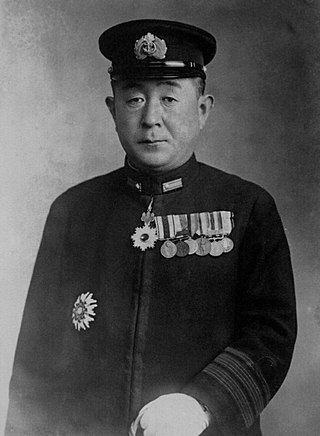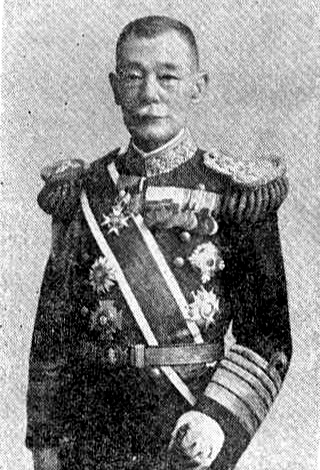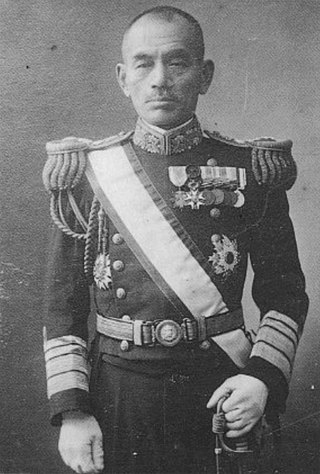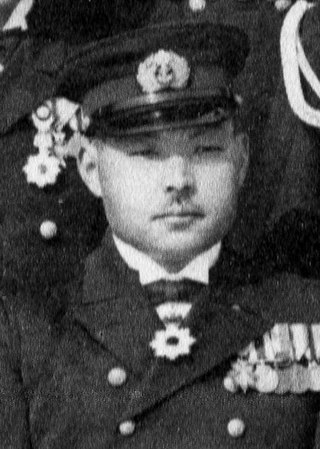Early years
Establishment of the Officer Corps

The first steps to train a modern officer corps was the establishment of a naval academy. [1] A facility was established in 1869 at Tsukiji in Tokyo and later relocated to Etajima in 1888, not far from Hiroshima on the Inland Sea. Members who originated from the coalition of the south western domains initially dominated the navy's small officer corps. This stranglehold over the officer corps was in large part, was reflective of the naval strength that had been accumulated by the various anti-Tokugawa domains. [2] Beginning in 1870, the most powerful han (domains) with independent naval forces offered their vessels to the government, they did so on the condition that the officers and enlisted personnel who manned them would subsequently obtain positions and rank in the new navy. [2] Since Satsuma, offered the three largest warships to the new government, it also provided more officers and enlisted sailors than any other domain. [2]
In the initial recruitment of new cadets for the Naval Academy, the Hyōbushō (Military Ministry) drew heavily from bakumatsu-era precedents. Which was similar to the recruitment of cadets at the two Dutch-assisted bakufu naval training centers that had opened in 1855 and 1857, respectively, it continued a tribute system to secure cadets. Domains of the 17 original anti-bakufu coalition that possessed naval units, were ordered to provide cadets to the academy based on the size of their respective domains. [2] Within this scheme, the larger political domains provided five students, and the smaller ones provided three each. As Chōshu, Satsuma, and Hizen were three of the most important naval domains, they sent the largest contingents. [2] Furthermore, Satsuma officials also sent fourteen full-fee paying day students along with the five tribute students, giving their domain the largest single representation at the academy. However, quality did not match quantity, and as a result the first batch of students sent under the tribute system failed to impress either the academy authorities or officials in the Military Ministry. Of the original 114 students who attended the academy in 1870, only two remained for the full course and graduated in 1873, this dismal performance motivated the government to implement changes. [4]
Japan's early naval leadership was aware of the severely limited economic and material resources of the country at the time, leading to initial priority given to the education and training of officers and men rather than to the acquisition of additional naval vessels. [1] Conscious of the fact that officers could not be trained overnight, they set about a reorganization of the naval academy; viewing this as essential and realizing that this was a cost-effective means of establishing the foundations for a future navy. [4] Therefore, after the first full year of subjects, the academy implemented a revised program to secure better recruits. As a first step, the government abolished the feudal recruitment and enrollment program which had been retained by the new government. Not only did such a system provide no quality control over cadets, but it also led to a continuation of regional identities among cadets and did little to cultivate the aura of a national navy. [4]
In 1871, the government implemented a new policy for naval officer recruitment, one that had wide-ranging political, geographical, and social implications for the navy. [4] First, the navy made enrollment contingent upon the successful completion of an entrance examination. [4] Second, in order to attract anyone of outstanding intellectual ability and in an effort to make the navy a national service, the navy opened applications to anyone who desired a naval career regardless of their social or geographical origin. [4] Although individuals of samurai background made up the vast majority of cadets in the early Meiji period, accounting for 90 percent of those who enrolled in 1874, the implementation of an examination-based entrance qualification led to a noticeable increase in officers of commoner background, who had been exposed to little or no previous military training. By 1891, commoners (heimin) accounted for just over 21 percent of the academy's graduates, a figure which would increase to 34 percent in 1901. [4]
During an average course of four years, cadets at the Imperial Naval Academy were taught various subjects in naval science such as seamanship, navigation, and gunnery, as well as general education subjects. The training program stressed physical fitness and toughness and placed great emphasis on the traditional Japanese military values of loyalty, courtesy, valor, and simplicity. [1]
Enlisted personnel
While the beginnings of a professional officer corps were being established, similar steps were taken to train the sailors and petty officers who would man the future navy. [3] Unlike the army, the navy initially avoided using the universal conscription act of 1873, instead seeking to recruit volunteers rather than conscripts into its ranks. [3] There was preference for those who already knew something of the sea, particularly for the sons of fishermen between the ages of 18 and 25. [3] Later, as the navy grew, its enlisted personnel were drawn from both volunteers and conscripts. [3] Of necessity, the initial training of navy enlisted personnel focused on instilling an esprit de corps that fostered patriotism and loyalty, while renewing traditional Japanese military virtues of courage and obedience. [3]
After being recruited by local recruitment centers, the recruits were sent to Kaiheidan (海兵団) units in either of the four naval districts (Yokosuka, Kure, Sasebo and Maizuru) that were responsible for training of enlisted and non-commissioned officer personnel for the navy. [5]



















